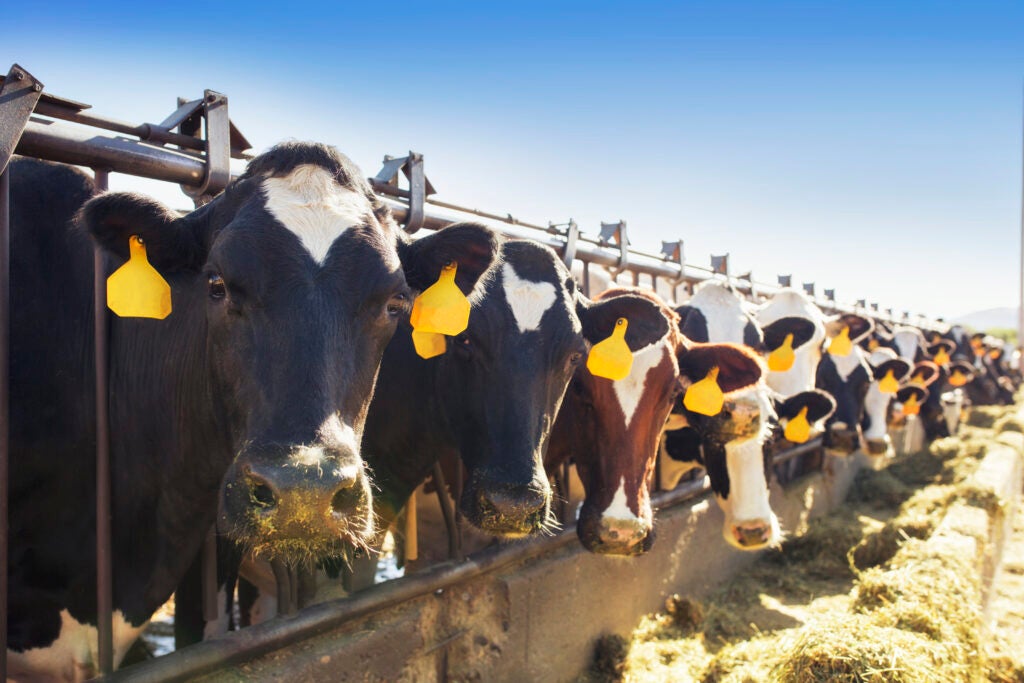By Mallory Honan, Scientist, Livestock Methane; Jack Killcoyne, Senior Research Analyst, Global Livestock Methane; Peri Rosenstein, Senior Scientist, Livestock Systems
A dairy cow’s diet is an integral part of her well-being and productivity; it’s also a critical opportunity for reducing methane emissions. Similar to humans, what cows eat impacts their ability to live healthy, productive lives. Therefore, a major priority for farmers and nutritionists is formulating a diet that satisfies their cows’ dietary requirements.
Unlike humans, though, cows are ruminants — animals that have a compartmentalized digestive organ (three pre-stomachs and one true stomach) — and they digest food very differently. The largest component of their pre-stomach and main site of digestion is aptly named the rumen. This chamber acts as a fermentation vat, with microbes breaking down nutrients from feed. The cow then burps out methane produced as a byproduct via these microbial digestive processes, also known as enteric fermentation.
Nutrition modeling and methane prediction
Cows can eat a variety of feed ingredients but predominantly consume grass or hay, silage (fermented forage) and grains. Together, all ingredients can be combined to form a total mixed ration — a mixture of all essential ingredients for the cow. Diets can be formulated by incorporating various feed ingredients and balancing carbohydrates, proteins, starches, fiber and other inputs, such as minerals, amino acids or fatty acids. For example, corn is commonly utilized as a source of carbohydrates, and alfalfa is a high-protein forage.
The Cornell Net Carbohydrate and Protein System (CNCPS) is the most used nutritional model to create diets for dairy cows in the United States (Prestegaard-Wilson, 2021). It can inform farmers and nutritionists, the experts who formulate a cow’s diet, as to what nutrients their cows need to ensure a balanced diet for optimal health and productivity. The model, originally developed by Cornell University (CNCPS), has been a critical resource for nutritionists for 35 years, becoming further refined as research on nutrient needs and management for cows has grown.
A recent analysis demonstrates the ability of the CNCPS model to quantitatively predict enteric methane production based on diet, presenting an exciting opportunity to leverage this invaluable nutrition tool for addressing enteric methane emissions in the future. The model represents cattle biology through hundreds of equations that describe rumen fermentation, digestion, passage rate and animal requirements. Some mechanisms of action and pathways are still challenging to capture within the program, but the model is constantly evolving and its predictive capability is improving.
Enteric methane reduction and estimation
One way to reduce enteric fermentation is through the use of feed additives. These products are added to a cow’s diet to reduce the amount of enteric methane she produces. Incorporating feed additives for enteric methane reduction into CNCPS is highly beneficial, allowing for cows’ nutritional and productivity impacts to be accounted for within a standard program already being used for diet formulation. This can give nutritionists the confidence to build healthy and effective diets that include these feed additives. Additionally, CNCPS provides an accurate estimation of methane emissions from a typical cattle diet and could potentially account for the impacts of feed additives for enteric methane reduction, provided future studies are conducted.
A subset of data gathered from an ongoing study at Cornell University included five repetitions of measurements of methane emissions collected from heifers (young, pre-lactating cows) for 72 hours in respiration chambers, which are considered the “gold standard” measurement technology. After detailed diet and feed nutrition information from the study and the heifer’s characteristics were gathered, CNCPS was deployed to make a side-by-side comparison of its prediction of enteric methane with what was quantified by the respiration chambers. The five timepoint measurements and associated predicted values were collectively tested for significant differences, which indicated that CNCPS predicted values were not different from respiration chamber data. In summary, this means that CNCPS accurately predicted methane emissions produced by the heifers.
What’s the future of nutrition programs for methane?
Environmental Defense Fund and Cornell Atkinson Center for Sustainability are closely collaborating to develop guidelines on the specific requirements of new feed additives for enteric methane reduction to be incorporated into CNCPS. The goal is to clearly define the requirements, so product developers know the expectations going into the design of their research programs. With this guidance, they can maximize their resources to conduct the necessary studies and obtain the required data in combination with other research program goals, such as federal regulatory review and approval.
The ability to predict methane emissions from cattle diets is another step toward making methane reductions clearer and more achievable. Addressing methane emissions from livestock through strategies such as cattle nutrition presents a clear opportunity for climate action.
Read the full report on CNCPS and methane here.
We would like to acknowledge our partners at Cornell University Department of Animal Science, Mike Van Amburgh and Ananda Fontoura, for their collaboration on this project.









